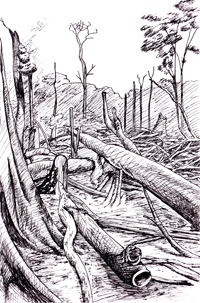In the past 10 years [prior to 2013], India’s environmental movement has had a rebirth. It was first born in the 1970s, when the industrialised world was seeing the impact of growth on its environment. […]
It was also in the 1970s that the second environmental challenge—issues of access and sustainable management of natural resources—emerged. In the remote Himalayas, the women had prevented the timber merchants from cutting their forest. But their fight was not to protect the forest. Their fight was to assert their right to the resources of the forest. It was an environmental movement because the women of this village in Chamoli district of Uttarakhand knew they had to protect the forest to protect their livelihood. It was a call to redefine development and growth.
But it is only now that these two sides of the environmental challenge have truly come home to India. Importantly, this is a time when environmental issues have taken centre stage in the country. Yet matters are going from bad to worse. The pollution in our rivers is worse today than it was three decades ago. The garbage in cities is growing by the day, even as governments scramble to find ways of reducing plastic and hiding the rest in landfills in far-off places. Air pollution in cities is worse, and toxins are damaging our lungs.
This, in spite of efforts to contain the problem. […]
The fact is in India a large number of people—and it is indeed a large number—depend on the land, the forests and the water around them for their livelihood. They know that once these resources are gone or degraded their survival will be at stake.
We must recognise that across the world, the environmental movement is based on the idea that people do not want anything bad in their vicinity: not in my backyard or NIMBY. […]
When the urban and middle-class India—as across the world—faces an environmental threat it does not stop to ask in whose backyard it should be allowed. The fact is garbage is produced because of our consumption. The richer we get, the more waste we generate and the more we pollute. […]
In middle-class environmentalism there is no appetite for changing lifestyles that will minimise waste and pollution. […]
We can do things differently to reinvent growth without pollution. But only if we have the courage to think differently. I hope we will.
Source: “India’s twin environmental challenges” by Sunita Narain (Down To Earth, 15 December 2013)
Address : https://www.downtoearth.org.in/content/india-s-twin-environmental-challenges
Date Visited: 22 February 2021
Learn from M S Swaminathan – a world renowned scientist – how biological diversity contributes to public health, people’s livelihood and environmental security in addition to food security: his call on fellow citizens to use and share resources in a more sustainable and equitable manner; outlining the long journey from the 1992 Earth Summit to a commitment to foster inherited knowledge through India’s Biodiversity Act and Genome Saviour Award; an award intended to reward those who are “primary conservers” – guardians of biological diversity!
More about the work of his foundation which “aims to accelerate use of modern science and technology for agricultural and rural development to improve lives and livelihoods of communities.” – www.mssrf.org | Regarding the issues of food security raised above, and the nutritional value of indigenous grains, seeds and millets, read an in-depth report that concludes that “the tribal food basket has always been diverse and nutritious” >>
Up-to-date reports by Indian experts and journalists
Search tips
Combine the name of any particular state, language or region with that of any tribal (Adivasi) community.
Add keywords of special interest (music, poetry, dance just as health, sacred grove and biodiversity); learn about the rights of Scheduled Tribes such as the “Forest Rights Act” (FRA); and the United Nations “Declaration on the Rights of Indigenous Peoples”, “Universal Declaration of Human Rights”, “women’s rights”, or “children’s right to education”.
Specify any other issue or news item you want to learn more about (biodiversity, bonded labour and human trafficking, climate change, ecology, economic development, ethnobotany, ethnomedicine, global warming, hunter-gatherers in a particular region or state, prevention of rural poverty, water access).
For official figures include “scheduled tribe ST” along with a union state or region: e.g. “Chhattisgarh ST community”, “Himalayan tribe”, “Scheduled tribe Tamil Nadu census”, “ST Kerala census”, “Particularly Vulnerable Tribal Group Jharkhand”, “PVTG Rajasthan”, “Adivasi ST Kerala”, “Adibasi ST West Bengal” etc.
In case the Google Custom Search window is not displayed here try the following: (1) toggle between “Reader” and regular viewing; (2) in your browser’s Security settings select “Enable JavaScript” | More tips >>
Note: hyperlinks and quotes are meant for fact-checking and information purposes only | Disclaimer >>
List of websites covered by this Google custom search engine
Academia.edu (platform for academics to share research papers) – www.academia.edu
Archive.org – https://archive.org
Centre for Science and Environment – https://www.cseindia.org
Current Conservation – https://www.currentconservation.org
Development and Cooperation (D+C) https://www.dandc.eu
Down To Earth (India) – www.downtoearth.org.in
India Environment Portal – www.indiaenvironmentportal.org.in
Harnessing Nature Magazine – https://harnessingnature.online
Mongabay-India – https://india.mongabay.com
M S Swaminathan Research Foundation – www.mssrf.org
Navdanya (protecting India’s biodiversity based food heritage) – https://navdanya.org
Third World Network (Penang, Malaysia) – https://twn.my
The Shola Trust (nature conservation in the Nilgiri region) – www.thesholatrust.org
WorldCat (“the world’s largest library catalog, helping you find library materials online”) – https://worldcat.org
Research the above issues with the help of Shodhganga: A reservoir of theses from universities all over India, made available under Open Access >>
Note: hyperlinks and quotes are meant for fact-checking and information purposes only | Disclaimer >>
“Movements of farmers and farm labourers […] are headed for serious trouble if they do not factor in the problems of climate change (which have already devastated agriculture in India); if they do not locate themselves in, and link their battles to, an agroecological approach.” – P. Sainath in “We Didn’t Bleed Him Enough”: When Normal is the Problem (counterpunch.org, 12 August 2020, first published in Frontline magazine) | More about climate change | United Nations on climate change >>

Listen to (Land) Back to the Future by Riley Yesno on the CBC Ideas website >>
“In less than 200 years, photography has gone from an expensive, complex process to an ordinary part of everyday life. From selfies to satellites, most of the technology we use and spaces we inhabit rely on cameras. […] While photographic documentation can aid in shaping history, it can also be a window into the horrors of the past.” – Read more or listen to Butterfly Effect 9 – The Camera on CBC Radio Spark 26 May 2023 >>
Find publications by reputed authors (add “open access” for freely downloadable content)
PDF-repository: texts quoted & further reference (Google Drive) >>
Research the above issues with the help of Shodhganga: A reservoir of theses from universities all over India, made available under Open Access >>
Related posts

“We can do things differently to reinvent growth without pollution. But only if we have the courage to think differently.” – Sunita Narain in Down To Earth >>
Learn more
Atree.org | Ashoka Trust for Research in Ecology & the Environment (posts)
Biodiversity | Hyderabad biodiversity pledge | Nilgiri Biosphere
Climate change | Audio | The Climate Question (BBC Podcast)
eJournals & eBooks | Background guide for education
eLearning: Center for World Indigenous Studies
Forest Rights Act (FRA) | Hunter-gatherers | Legal rights over forest land
Health and nutrition | Recommendations by the Expert Committee
“The tribal food basket has always been diverse and nutritious”
United Nations on climate change
What is the Forest Rights Act about?
Who is a forest dweller under this law, and who gets rights?
Tips for using interactive maps
Toggle to normal view (from reader view) should the interactive map not be displayed by your tablet, smartphone or pc browser
For details and hyperlinks click on the rectangular button (left on the map’s header)
Scroll and click on one of the markers for information of special interest
Explore India’s tribal cultural heritage with the help of another interactive map >>